NCERT Solutions for Class 5 Maths Mela Chapter 1 We the Travellers I (New Edition) for Session 2025–26. Maths Mela chapter 1 gives a well-structured answers based on the latest syllabus. This chapter helps students understand large numbers, place value, number patterns, rounding off and units of distance through fun, travel-based contexts. The solutions include clear explanations, activities and step-by-step reasoning to build strong number sense. Ideal for revision and classroom learning, these answers follow the updated NCERT format.
Class 5 Maths Mela Chapter 1 Solutions
Class 5 Maths Mela Chapter 1 MCQ
Class 5 Math Magic Chapter 1 Solutions
Class 5 Maths all Chapters Solutions
We the Travellers I Class 5 Maths Mela Chapter 1 Solutions
Page 5
Let Us Do
1. Fill in the blanks by continuing the pattern in each of the following sequences. Discuss the patterns in class.
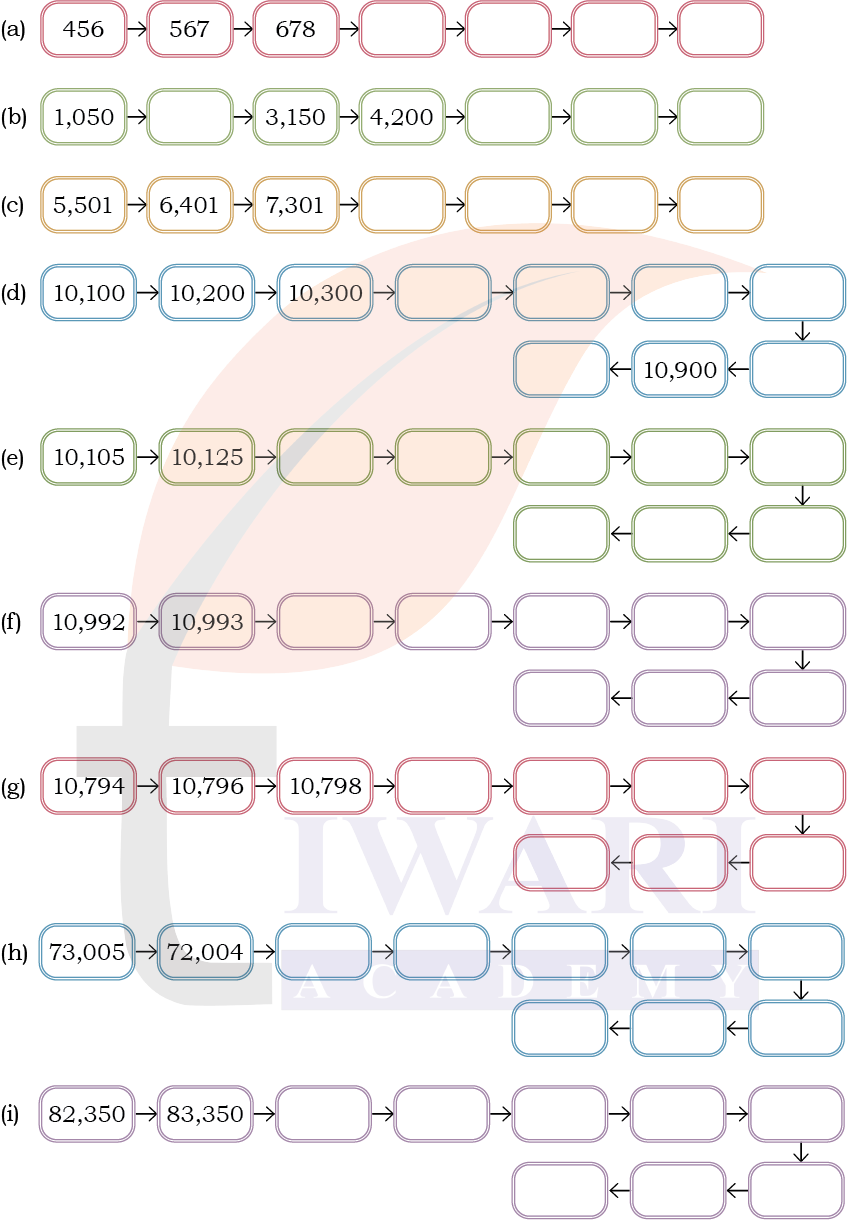
Answer:
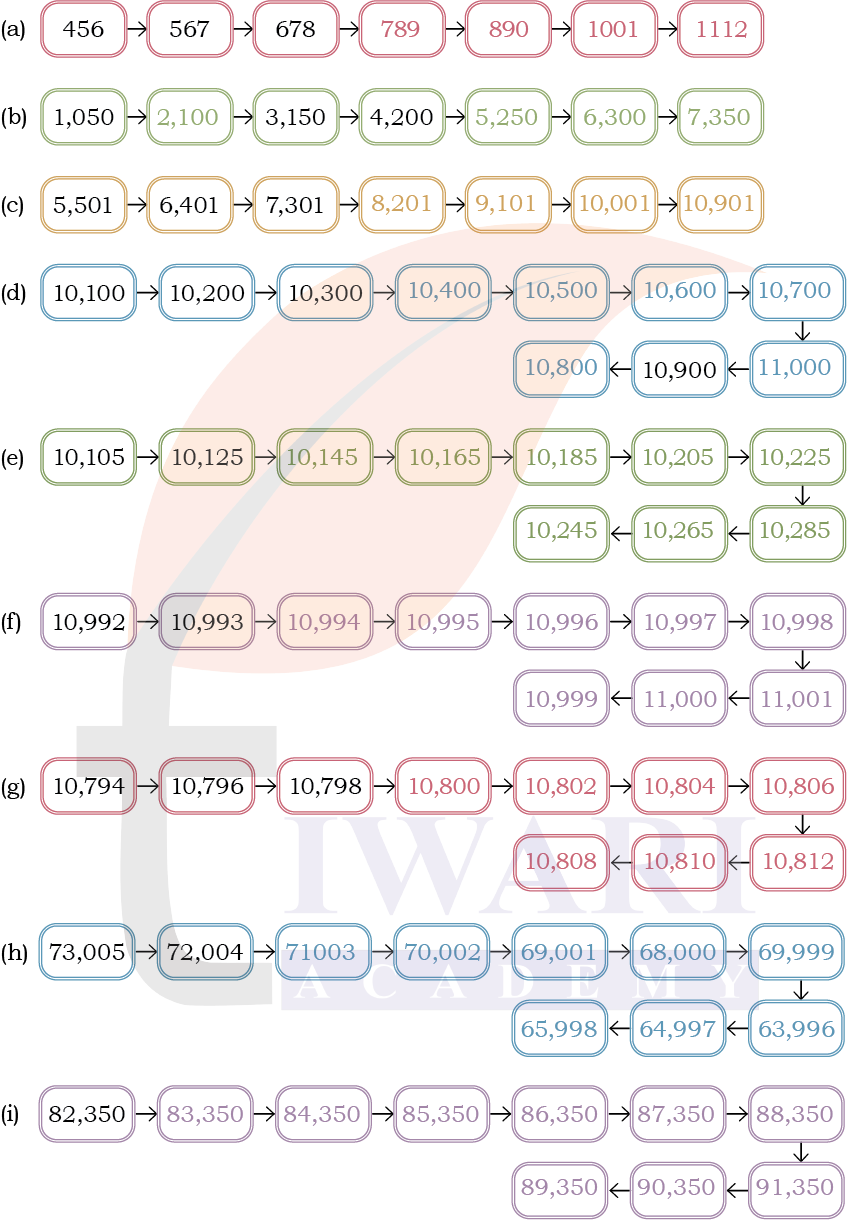
2. Fill in the blanks appropriately. Use commas as required.
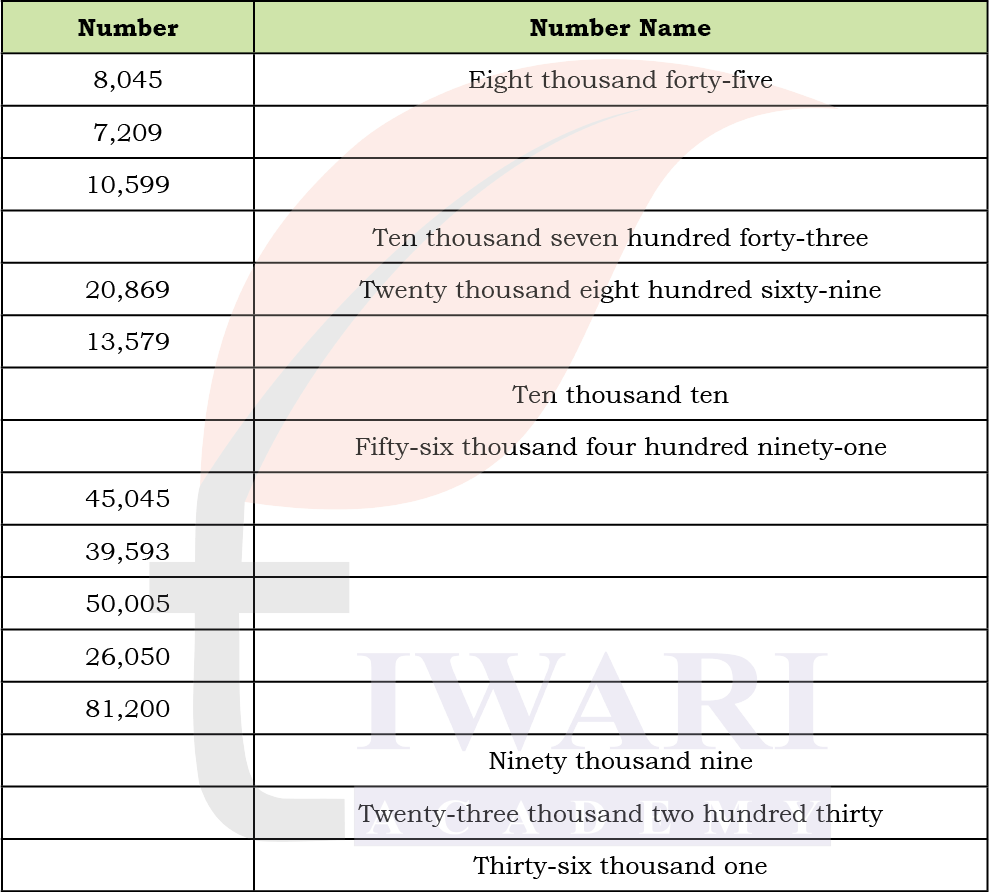
Answer:
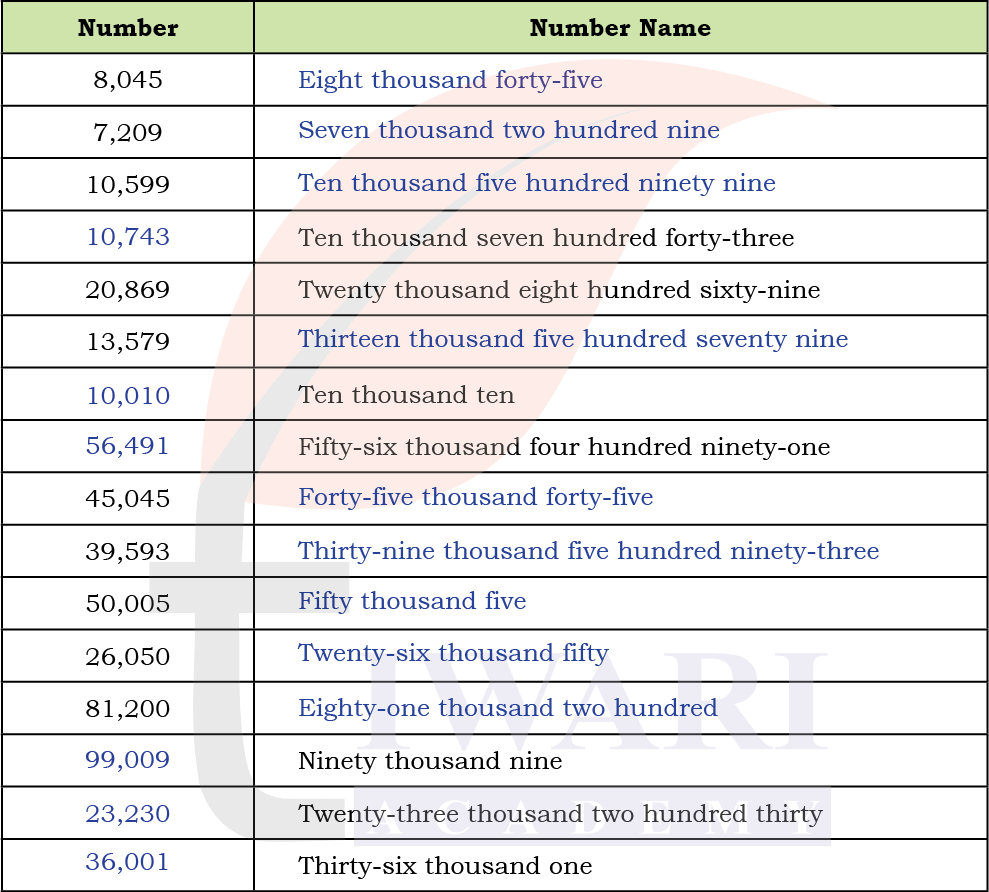
3. Arrange the numbers below in increasing order. You can use the number line below, if required.

See Solution18926, 34407, 34740, 40347, 40473, 47340, 73404, 74430

4. A student said 9,990 is greater than 49,014 because 9 is greater than 4. Is the student correct? Why or why not?
Use the number line below to find the position of the numbers. Fill in the blanks.

See SolutionOn a number line, numbers increase as we move to the right. So, a number with more digits is always greater than a number with fewer digits.
9,990 has 4 digits
49,014 has 5 digits
So, 49,014 is much farther to the right on the number line than 9,990.
Even though 9 is greater than 4 in the first digit, we must compare the entire number, not just the first digit.

5. Digit swap
(a) In the number 1,478, interchanging the digits 7 and 4 gives 1,748. Now, interchange any two digits in the number 1,478 to make a number that is larger than 5,500.
See Solution(a) Original number: 1,478
Interchanged digits: 7 and 4 → 1,748 (Already done)
Now, try to find a number greater than 5,500 by swapping any two digits:
• Swap 1 and 8 → 8,471 (greater than 5,500)
• Swap 1 and 7 → 7,418 (greater than 5,500)
• Swap 1 and 4 → 4,178 (less than 5,500)
So, the Possible numbers greater than 5,500 are 8,471, and 7,418.
(b) Interchange two digits of 10,593 to make a number
i) Between 11,000 and 15,000.
ii) More than 35,000.
See Solution(b) Original number: 10,593
i) Between 11,000 and 15,000:
Try by swapping:
Swap 0 and 5 → 15,093
Swap 1 and 3 → 30,591
Swap 1 and 5 → 50,193
Swap 0 and 3 → 13,590 (Between 11,000 and 15,000)
So, the number between 11,000 and 15,000 is 13,590.
ii) More than 35,000:
Try by swapping:
Swap 1 and 5 → 50,193 (more than 35,000)
Swap 1 and 9 → 90,513 (more than 35,000)
Swap 0 and 9 → 19,503 (less than 35,000)
So, the numbers more than 35,000 are 50,193 and 90,513.
(c) Interchange two digits of 48,247 to make a number
i) As small as possible.
ii) As big as possible.
See Solution(c) Original number: 48,247
i) As small as possible:
We want smallest number → put smallest digits in the highest places.
Try by swapping:
Swap 4 and 2 → 28,447
Swap 4 and 7 → 78,247
Swap 4 and 8 → 84,247
Swap 8 and 2 → 42,847
So, the smallest number is 28,447.
ii) As big as possible:
We want largest number → put largest digits in the highest places.
Try by swapping:
Swap 4 and 2 → 28,447
Swap 4 and 7 → 78,247
Swap 4 and 8 → 84,247
Swap 8 and 2 → 42,847
So, the largest number is 84,247.
Class 5 Maths Mela Chapter 1 Question Answers
Page 8
Let Us Think
1. Vijay rounded off a number to the nearest hundred. Suma rounded off the same number to the nearest thousand. Both got the same result. Circle the numbers they might have used.
See SolutionLet’s check each number one by one:
• 7126
Nearest hundred = 7100
Nearest thousand = 7000
Not same
• 7835
Nearest hundred = 7800
Nearest thousand = 8000
Not same
• 7030
Nearest hundred = 7000
Nearest thousand = 7000
Same
• 6999
Nearest hundred = 7000
Nearest thousand = 7000
Same
So, they might used 7030 or 6999.

2. Think and write two numbers that have the same –
(a) Nearest ten.
See Solution(a) Nearest Ten: 38 and 42
Both round off to 40 (nearest ten)
(b) Nearest hundred.
See Solution(b) Nearest Hundred: 248 and 198
Both round off to 200 (nearest hundred)
(c) Nearest thousand.
See Solution(c) Nearest Thousand: 3,426 and 3,499
Both round off to 3,000 (nearest thousand)
3. Think and write the numbers that have the same –
(a) Nearest ten and nearest hundred.
See Solution(a) Same Nearest Ten and Nearest Hundred: 195 and 204
Both round to 200 (nearest ten)
Both also round to 200 (nearest hundred)
(b) Nearest hundred and nearest thousand.
See Solution(b) Same Nearest Hundred and Nearest Thousand: 949 and 915
Both round to 1,000 (nearest thousand)
Both also round to 1,000 (nearest hundred)
(c) Nearest ten, hundred and thousand.
See Solution(c) Same Nearest Ten, Hundred and Thousand: 1,000 and 1,004
Both round to 1,000 for nearest ten, hundred and thousand.
Page 10
Let Us Do
1. A cyclist can cover 15 km in one hour. How much distance will she cover in 4 hours, if she maintains the same speed?
See SolutionA cyclist goes 15 kilometres in 1 hour.
So, in 4 hours, she will go 15 × 4
= 60 kilometres
2. A school has 461 girls and 439 boys. How many vehicles are needed for all of them to go on a trip using the following modes of travel?
The numbers in the bracket indicates the number of people that can travel in one vehicle.
(a) Bicycle ( 2)
(b) Autorickshaw ( 3)
(c) Car ( 4)
(d) Big car ( 6)
(e) Tempo traveller (10)
(f) Boat ( 20)
(g) Minibus ( 25)
(h) Aeroplane (180)
See SolutionNumber of Girls = 461
Number of Boys = 439
Total number of students = 461 + 439 = 900
Now we divide 900 by the number of people each vehicle can carry to find how many vehicles are needed. If there’s any remainder, we add 1 extra vehicle.
(a) Bicycle (2 people)
So, 900 ÷ 2 = 450 bicycles
(b) Autorickshaw (3 people)
So, 900 ÷ 3 = 300 autorickshaws
(c) Car (4 people)
So, 900 ÷ 4 = 225 cars
(d) Big car (6 people)
So, 900 ÷ 6 = 150 big cars
(e) Tempo traveller (10 people)
So, 900 ÷ 10 = 90 tempo travellers
(f) Boat (20 people)
So, 900 ÷ 20 = 45 boats
(g) Minibus (25 people)
So, 900 ÷ 25 = 36 minibuses
(h) Aeroplane (180 people)
So, 900 ÷ 180 = 5 aeroplanes
Grade 5th Maths Mela Chapter 1 Answer Explanation
Page 13
Let Us Do
1. Write 5 numbers between the numbers 23,568 and 24,234.
________, _______, ________, ________ and _______
See SolutionThe 5 numbers between 23,568 and 24,234:
23600, 23750, 23890, 24000 and 24123
2. Write 5 numbers that are more than 38,125 but less than 38,600.
________, ________, ________, ________ and ________
See SolutionThe 5 numbers that are more than 38,125 but less than 38,600:
38200, 38310, 38420, 38500 and 38590
3. Ravi’s car has been driven for 56,987 km till now. Sheetal’s car has been driven 67,543 km. Whose car has been driven more? ____________.
See SolutionComparing the distances:
Distance traveled by Ravi’s car = 56,987 km
Distance traveled by Sheetal’s car = 67,543 km
Since 67,543 > 56,987,
So, Sheetal’s car has been driven more.
Now, 67,543 − 56,987 = 10,556
So, Sheetal’s car has been driven 10,556 more than Ravi.
4. The following are the prices of different electric bikes. Arrange the prices in ascending (increasing) order.
₹90000, ₹89999, ₹94983, ₹49900, ₹93743, ₹39999
See SolutionPrices of different electric bikes in increasing order:
₹39999, ₹49900, ₹89999, ₹90000, ₹93743, ₹94983
5. The following table shows the population of some towns. Arrange them in a descending (decreasing) order.
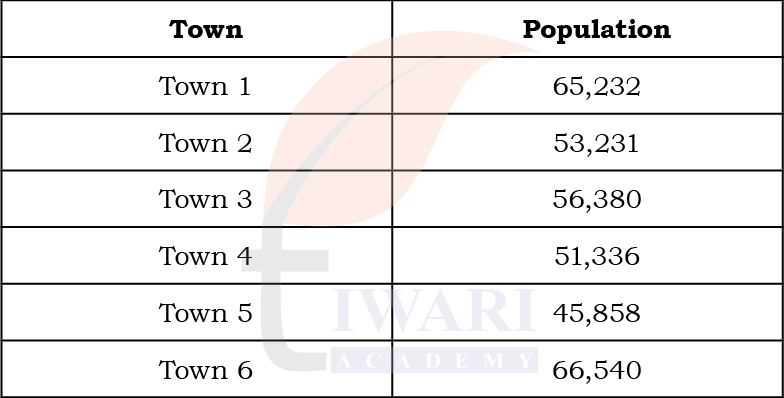
See SolutionDescending order: 66540, 65232, 56380, 53231, 51336, 45858
Descending order: Town 6, Town 1, Town 3, Town 2, Town 4, Town 5
Class 5 Maths Mela Chapter 1 Question 6 and 7
6. Find numbers between 42,750 and 53,500 such that the ones, tens and hundreds digits are all 0?____________.
See SolutionNumbers between 42750 and 53500, whose ones, tens and hundreds digits are all 0:
43000, 44000, 45000, 46000, 47000, 48000, 49000, 50000, 51000, 52000 and 53000.
7. Write the following numbers in the expanded form. One has been done for you.
(a) 783 = 700 + 80 + 3
(b) 8,062 = ____________.
(c) 9,980 = ____________.
(d) 10,304 = ____________.
(e) 23,004 = ____________.
(f) 70,405 = ____________.
See SolutionExpanded form:
(a) 783 = 700 + 80 + 3 (Already done)
(b) 8,062 = 8000 + 60 + 2
(c) 9,980 = 9000 + 900 + 80
(d) 10,304 = 10000 + 300 + 4
(e) 23,004 = 20000 + 3000 + 4
(f) 70,405 = 70000 + 400 + 5
Grade 5 Maths Mela Chapter 1 All Questions
8. Fill in the blanks with the correct answer. Share your thoughts in class.
(a) 983 = 90 Tens + 83 Ones
(b) 68 = ___ Tens + 18 Ones
(c) 607 = 4 Hundreds + ___ Ones
(d) 5,621 = 4 Thousand + ___ Hundreds + 2 Tens + ___ Ones
(e) 7,069 = ___ Thousand + 20 Hundreds + ___ Ones
(f) 37,608 = ___ Ten Thousand + 17 Thousand + ___ Hundreds + 8 Ones
(g) 43,001 = 3 Ten Thousand + ____ Thousand + ____ Hundreds + 1 Ones
See Solution(a) 983 = 90 Tens + 83 Ones
(b) 68 = 5 Tens + 18 Ones
(c) 607 = 4 Hundreds + 201 Ones
(d) 5,621 = 4 Thousand + 16 Hundreds + 2 Tens + 1 Ones
(e) 7,069 = 5 Thousand + 20 Hundreds + 69 Ones
(f) 37,608 = 2 Ten Thousand + 17 Thousand + 6 Hundreds + 8 Ones
(g) 43,001 = 3 Ten Thousand + 10 Thousand + 30 Hundreds + 1 Ones
9. Fill in the blanks with the correct answers.
(a) How many notes of ₹10 are there in ₹7,934? 793
(b) How many notes of ₹100 are there in ₹7,934? _______
(c) How many thousands are there in 7,934? _______
(d) How many ₹500 notes are there in ₹7,934? _______
(e) How many notes of ₹10 are there in ₹65,342? _______
(f) How many notes of ₹100 are there in ₹65,342? _______
(g) How many thousands are there in 65,342? _______
(h) How many ₹500 notes are there in ₹65,342? _______
See Solution(a) ₹7,934 ÷ ₹10 = 793 notes of ₹10 (Already given)
(b) ₹7,934 ÷ ₹100 = 79 notes of ₹100
(100 × 79 = ₹7,900)
(c) ₹7,934 has 7 thousands
(1,000 × 7 = ₹7,000)
(d) ₹7,934 ÷ ₹500 = 15 notes
(500 × 15 = ₹7,500)
(e) ₹65,342 ÷ ₹10 = 6,534 notes of ₹10
(f) ₹65,342 ÷ ₹100 = 653 notes of ₹100
(g) ₹65,342 has 65 thousands
(1,000 × 65 = ₹65,000)
(h) ₹65,342 ÷ ₹500 = 130 notes of ₹500
(500 × 130 = ₹65,000)
Is Class 5 Maths Mela Chapter 1 easy?
Yes, Chapter 1 is quite easy and fun to learn. It uses real-life travel situations to explain big numbers, distances and place values. With number lines, charts and puzzles, the concepts become simple to understand.
How to solve Class 5 Maths Mela Chapter 1 in one day?
To complete the chapter in one day:
• Read the story and examples carefully.
• Solve the place value table and number patterns.
• Practice rounding off and comparison questions.
• Try the puzzles and activities at the end.
Which topic of Class 5 Maths Mela Chapter 1 is most important?
The most important topic is reading and writing large numbers using the Indian place value system, especially up to ten-thousands, along with rounding off and distance estimation.
What are the key points of Class 5 Maths Chapter 1 for Exams?
• Place value (Ones to Ten-thousands)
• Reading and writing numbers with commas
• Expanded and short forms
• Number comparison and ordering
• Rounding off to nearest tens, hundreds, and thousands
• Simple distance and travel-related calculations
These are frequently asked in exams.


